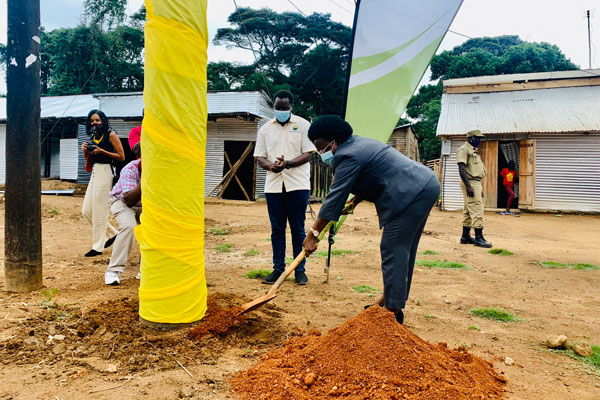Why Shs32b Kalangala marine power cable project has delayed

Ms Mary Goretti Kitutu, the then Minister for Energy, commissions the launch for the construction of the submarine cable project in Bugoma, Kalangala District, in October last year. PHOTO/COURTESY
What you need to know:
- Government attributes the delays to the pandemic. The contractor recently started manufacturing the cable
W hen electricity was extended to Buggala Island in Kalangala District in 2005, Mr Simon Kimera, a resident of Lusozi Landing Site, was one of the excited islanders.
But 16 years later, power has not yet reached Mr Kimera’s village despite having money to pay for the service.
The implementation of the new Shs32b power submarine cable project launched in October last year, which is intended to boost power supply in the area, has also been delayed.
The project connecting Kalangala Island to the main power grid from a power station at Bukakkata in Masaka District is being rolled out under the Uganda Rural Electricity Access project.
These delayed efforts have dampened hopes of islanders to get reliable power supply.
“We are still waiting to see power extended to our village. We hope its [project] implementation was not affected by the Covid pandemic like some government projects,” Mr Kimera said on Sunday.
Currently, nine out of 33 landing sites on Buggala Main Island have no power connection, which has retarded development in the area.
Landing sites with power include Kasamba, Lwabalega, Katooke, Buyiri, Kisalamala, Bwamba, Lusozi, Semasiga and Mukoko in Mugoye Sub-county.
Ms Irene Batebe, the Permanent Secretary in the Ministry of Energy attributed the delays to the Covid-19 pandemic.
However, work started recently and the contractor is embarking on manufacturing the cable. The project is undertaken by CCC (Beijing) Industrial and Commercial Company Ltd.
“The cable is being manufactured while pole erection is ongoing at the island. The commissioning of the cable is projected to be in March 2022 and later, we will see some islands connected to the national power grid,” Ms Batebe said.
Currently, Kalangala Infrastructure Services (KIS) supplies power to only 39 villages out of 63 villages on Buggala Main Island, but Ms Batebe said with a submarine cable, power will be extended to other islands such as Bunyaama, Bufumira and Kitobo to save them from the stand alone solar mini grids with their related problems.
Mr Rajab Ssemakula, the Kalangala District chairperson, said he is optimistic that the project will stimulate development in the area.
“ What is on ground is giving hope. I have seen the contractor erecting some poles at Lwabalega and Kasamba landing sites and we hope everything will go as planned so that our people can start enjoying power at a relatively cheaper price compared to the current prices ,” he said.
“High power tariffs have chased away investors, especially those who want to build big factories that require huge power supply,” Mr Ssemakula added.
Some of the work expected to commence soon includes laying a seven kilometre submarine cable on the floor of Lake Victoria and constructing two 33 kilovolt switching sub-stations in Bukakkata and Bugoma, and 27 distribution transformers. Other tasks include construction of a medium voltage and low voltage network, installation of distribution transformers and protection equipment, and installation of last mile connections, including the supply of service cable, installation of prepaid metres and distribution ready boards to some 1,651 potential consumers.
The submarine cable is expected to complement the 1.6megawatts (per hour) solar power plant that KIS operates.
When the government unveiled the project last year, it drew mixed reactions from both residents and leaders, with some expressing fears that it may affect the aquatic life in Lake Victoria.
But the government allayed the fears, saying the power submarine cable will be strongly insulated and designed to be in water just like other submarine cables in other countries such as Tanzania and Madagascar.
Impact on businesses
“We are currently using ice to cool drinks, but we get that ice 25km away from here, which makes it expensive,” Mr Christopher Mwebe, a businessman at Kasamba Landing Site, said.
The available solar power supplied on Buggala Island is not enough to serve the ever-increasing power users, especially small and medium-sized manufacturers.
Mr Deogratius Kakumba, who owns an ice plant at Mwena Landing Site, said he cannot sustain his business due to unreliable power and high tariffs.
“I need to work only for a few hours when power is on, I can’t use the two machines at ago because when I do, power goes off in the village,” he said.
Mr Kakumba said he usually buys power worth Shs100, 000 to produce 1 tonne of ice which he sells at Shs120, 000.
“I register losses almost every week because many fish traders refuse to buy my ice complaining that it is of poor quality,” he said.
The power submarine cable will help stabilise power and reduce the cost of generating power as there will be no need to use generators, especially at night hours .
This will automatically lead to reduced power tariffs both domestic and commercial .
Background
Kalangala first received electricity in 2005, a geo-thermal power station working six hours a day covering only Kalangala Town Council. But two years later, residents complained, forcing the government through the Rural Electrification Agency (REA) to provide power for 10 hours –six hours during the day and four at night. In 2013, the government brought on board KIS, through a Public Private Plant partnership to provide full-time power supply on Buggala Main Island starting with the villages, leaving out Kalangala Town Council, which was already connected by REA.
Later, KIS signed an agreement to connect Kalangala Town Council to the solar grid. Kalangala, which comprises 84 islands and home of the African Grey parrots and unique vegetation and cultural features,is fast cutting itself a name as a tourist destination to reckon with . The completed Nyendo-Bukakkata Road is also expected to spur economic development in the island district.




